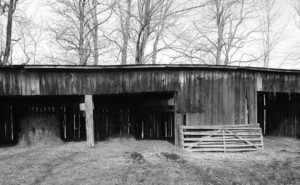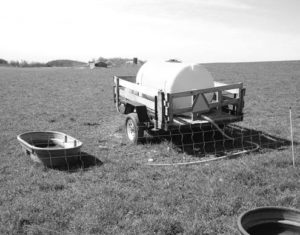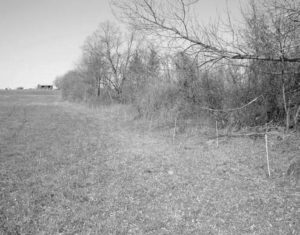How to Get Started with Sheep
Let’s assume you have a parcel of land. You would like to get started but you don’t know how. Here is an outline.

This ancient shed measures 900 square feet and would be suitable to raise up to 60 ewes with lambs. Photo by Ulf Kintzel
Pasture. If your parcel of land is a hayfield or has existing vegetation but there are lots of weeds, work with it. Don’t plow it up unless you have some extra money to spend. The “native” grasses you have there came for free and you will get them anyhow, even if you plow your field up and re-seed it. Frost seeding, especially frost seeding legumes, is a very inexpensive and very effective way of improving your existing stand of hay.
If your parcel of land was used to grow crops and you have to re-seed the land you will be faced with the question of what pasture mix to use. Many pasture mixes will have components that are either short lived or not optimal for grazing and are not much of a benefit to you. You can easily create your own pasture mix. I suggest a late heading orchard grass as the grass component and a long-lived legume like White Clover and your mix is actually ready.
Fencing. This will be one of the biggest, if not the single biggest expense. I suggest high-tensile woven wire as perimeter fence. It is the best physical barrier there is to keep sheep in and coyotes as well as stray dogs out. High tensile wire (unwoven) is a less expensive option. While this is less of a physical barrier and more of a mental barrier it is still quite effective. However, it doesn’t keep predators out the way woven wire does.

This ancient shed measures 900 square feet and would be suitable to raise up to 60 ewes with lambs. Photograph by Ulf Kintzel
Rotational grazing is a must if you want to graze your sheep in an economical way. That means you need interior fencing as well. For an interior fence you can choose between a portable electric fence and a permanent fence. A portable electric fence can be either posts and single strands of conductive twine or it can be electric netting. A portable fence will be less expensive and it will allow you to change the size and location of your grazing cells depending on the season.
If you are open to the idea, you can check with your local FSA or NRCS office if there are funds or grants available for a cost share program.
Barn/shelter. You will need a barn or shed for the sheep when the weather is severe and you will need a barn for lambing season. Keep in mind that the purpose of a barn for sheep is to protect it from the elements. It is not meant to provide warmth to the sheep. Thus, an old pole barn may suit the purpose just as long as the roof isn’t leaking and the side walls are somewhat intact.

These electric nettings are used as perimeter fence along a hedge row. Photograph by Ulf Kintzel
Water. Many bigger farms put out underground water lines to provide water for their sheep. That is a rather expensive way of getting water to a few sheep. In addition, it doesn’t allow for many changes once the water lines are laid. Instead, I suggest converting a little trailer into a water-hauling trailer. Farm stores sell tanks of various sizes for that purpose. Choose low troughs for sheep; troughs designed for horses or cattle will not allow lambs to reach the water.
Hay. Hay is used for the winter when the grass doesn’t grow anymore. For a small flock of sheep buying hay is far more economical than making it. A decent first cutting hay is nutritious enough to maintain a flock of sheep. I prefer to buy my hay from a local producer. Hay auctions at your local livestock or produce auction may be an alternative. So is buying hay through a known hay exchange website. Round bales are less expensive than small square bales. However, if you use round bales you need the means to move them while small square bales can be handled by hand.
The amount of hay fed in the winter can be reduced by grazing stockpiled pasture. Stockpiling can start as early as August when the grass has stopped producing seed stems and remains vegetative for the rest of the growing season.
Miscellaneous. There are many items that you will need. So, miscellaneous items may add up to a rather large expense. Here is a list of them: Mandatory Scrapie ear tags and applicator (call the USDA veterinary office for “free” tags), hoof cutter, pocket knife, panels for pens and jugs (rough-cut one-by-three Hemlock boards are an ideal and cheap material for making them), buckets, hay feeders (can be easily self-made from livestock panels), a crook to catch sheep, a drench gun for de-worming, a syringe and needles for emergency treatment and for vaccination against Over-eating disease, minerals and a container to feed minerals, and various items for lambing. This list may not be complete but it gives you an outline.
Sheep. After you have your setup in place and the logistics worked out you want to buy your sheep. Nowadays hair sheep like Dorper sheep and Katahdins are very popular since they don’t need shearing and are considered thrifty, easy-care sheep. If you choose a different breed I would advise looking for what is locally available rather than getting hooked on a breed first. Local sheep, sheep that are within a reasonable driving distance, are more likely to be adapted to your climate and environment. If economics are important to you, look at how productive the sheep are. You might want to stay away from exotic and rare sheep breeds, as they are exotic or rare for a reason.
Show sheep are likely to have a higher maintenance requirement than commercial sheep of the same breed. It is a good sign if the seller can provide economic records of his or her sheep such as lambs per ewe raised. Economic figures trump registration papers in my opinion. Registration with a breed organization doesn’t produce you any more lambs but may possibly help you later selling breeding stock.
I saved the biggest question for last. How many sheep per acre should you raise? This is the question I am asked the most often and that is the most difficult to answer. Stocking rate depends on many factors such as how improved the pasture is, climate, soil type, rotation schedule, and so forth. I would suggest to start safely and stock fairly low, say no more than two ewes per acre. You can increase the number of sheep over time should your farm have the ability to carry more sheep. I also suggest to never maximize your carrying capacity or to base your carrying capacity on the time when the grass grows best in the spring. If you do that, you will run out of grass sooner than you wish. If you have excess grass instead, you can always graze it in the winter and save some of the money you would have spent on hay.
Copyright 2010 Ulf Kintzel.
For permission to use either text or photographs please contact the author at ulf@whitecloversheepfarm.com.


It is very good. i would like to start sheep form.
That would be very good
I have 60 acres of pasture land in Illinois just north of St. Louis. There is spring fed creeks and a very lush grass that has been untouched by grazing for years. I would like to raise sheep to breed and sell yearlings for breading or meat. My question is what breed would be best and how many sheep could my property support with minimal hay assistance.
Thanks
Fred Westerhold.
Dear Mr. Westerhold,
Thank you for your patience. I believe that your land could accommodate well over 3, maybe even 4 sheep! This is exciting news to hear I am sure. Happy herding!
Nice article. I have a little 5 acre place and am considering a few sheep for wool. Just in the gathering information stage.
I raise katahdins. Good eating – no wool to fool with and easy care. Stated with 4 ewes three years ago. Now I have 13 ewes. Aiming for 30 as a base number. I’m in WV where the pasture is mostly hilsides and hollers. Mine run in about 7 acres of mixed bottom, wooded hillside and 2 acres of pasture. They are helping to keep the brush down as I slowly cut down the old growth brush. They eat the brush sprouts as it comes up after clearing. They love autumn olive. Also run three goats to help me clear brush. The new ram lambs go to another area where I summer on about 3 acres. This year I harvested 8 ram lambs.
So, you can do it while starting small, just keep swapping a new ram for breeding every year until you reach your head count goal. I have about 100 other acres to expand to as needed and 20 acres of hayfield.
How does your land do with that density? I have around 4 acres of pasture and considering sheep. Is there a reason we could also not have a chicken tractor in the same pasture?
I think if you want to do a leader/follower program you can run your chicken tractors in after the sheep. Check out NCAT/ATTRA for lots of info on this.
Running a chicken tractor in the same pasture At the same time as the lambs may not be good. You might find your lambs having a parasite problem. Better to run the chicken tractor after the lambs and then let the pasture sit so the cycle can be broken
Sheepies for the win
Educative article. Would like to start sheep farming too!
I north Florida State what is the best hay for sheep.
Hi John,
Our expertise at the Small Farms Program is for the northeast. I would recommend reaching out to the University of Florida County Extension for local assistance. http://sfyl.ifas.ufl.edu/who-we-are/
This is really a good and informative articles for those aspiring to rear sheep.
How do sheep take the mountain and a 11 or 12 hrs trip
Very educative.I have twelve access of land and I am really encouraged I will be in touch.
Waw,this is an important information for the biginners like me. God bless.
Up the sheepies